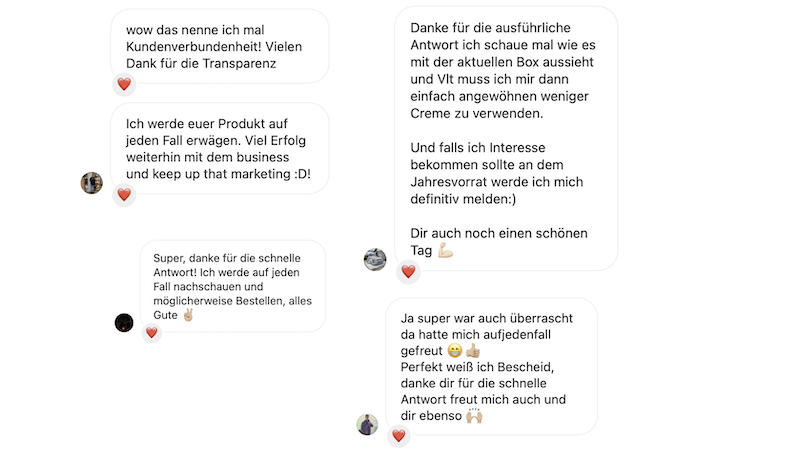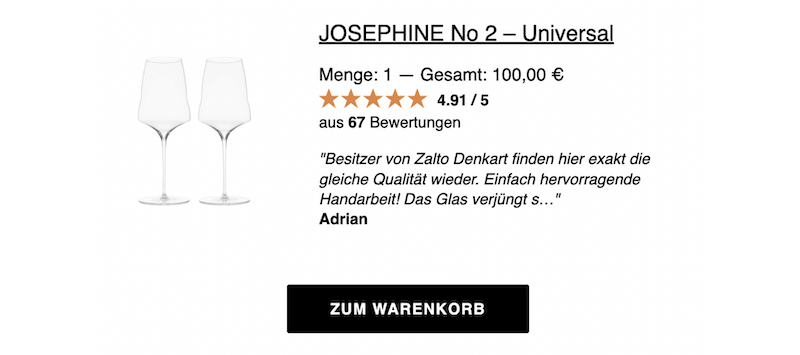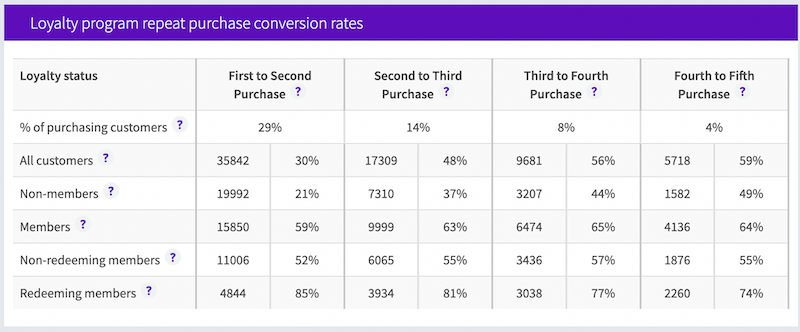"How do I retain my customers and save costs on acquiring new ones? The answer to "how"? - It's usually CRM!
Welcome to 2023, where precisely, that will be the big question for many e-commerce companies. "This year will be the one where the wheat is separated from the chaff in e-commerce", we hear numerous experts say. Because rising production prices, rising CPMs (Cost per 1000 impressions) and rising CACs (Customer Acquisition Costs) are meeting a declining consumer buying mood. It sounds unpleasant, and it partly is.
That's why it's even more important this year to optimize for profit instead of sales. This starts with the purchase of products, continues with customer acquisition, and extends to the loyal customer strategy. Everything can be optimized. But one crucial aspect is repeatedly clear: Whoever is capable of spending more money on new customers will win!
How does this work most easily? Through customer loyalty!
In this article, you will get an overview of customer loyalty in e-commerce from guest author Jakob Gerzen, and you will learn with which tools and application steps you can optimize your CRM strategy.
What does customer loyalty mean in e-commerce?
Customer loyalty or "Customer Loyalty" means initially that customers who have once bought from you will do so again. In the best case, this means you only have to bear the Customer Acquisition Costs once. In practice, of course, this is pure utopia. After all, not only new customers, but also your existing customers are repeatedly targeted by your advertising. Updates like iOS15 now also make it nearly impossible to effectively separate new from returning customers when running campaigns. The result: Blurred marketing costs that can only be attributed with great difficulty. What came from which channel? How many new customers were attracted by it?
When it comes to customer loyalty, two things are initially important: The proportion of buyers who buy from you again and – primarily those customers who do not make another purchase. A closer look at these two customer segments provides you with the answers you need for a successful CRM strategy (CRM = Customer-Relationship-Management; English umbrella term for customer loyalty management).
But why is customer loyalty in e-commerce so important?
Customer loyalty vs. new customer acquisition? In recent years, it has become increasingly difficult for online shops to be profitable from the first purchase of a customer. Those who acquire new customers via Facebook and Instagram find themselves in an auction system. This means: all brands and companies are competing for the best possible users for their products. Whoever can spend more, i.e., bid higher and more frequently, wins. At the same time, this means that you can grow much faster if your existing customer strategy allows you to acquire new customers at a loss. Simply by acquiring more customers. Simple, right? Not quite.
It is crucial to know your figures exactly: Let's assume you know that 30% of your new customers will shop with you again within 90 days and have even higher order values on average for the second purchase. This means for you that you could potentially acquire new customers at a loss and still be profitable at the end of the year. However, this calculation only works if you know both the proportion of your returning customers and their purchasing behavior. A Customer Journey Map can provide you with important insights here. But what counts in this step ultimately, is the so-called "CLV:CAC" ratio.
A good CRM strategy and examples of customer loyalty measures
So how do you create this sophisticated CRM machine that allows us to buy our new customers at a loss and still make profits? How do you keep data and figures so in sight that you don't act under false assumptions or buy the "wrong" customers who might not tend to make the second, third and repeated purchases in our shop? How do you ultimately build a scalable D2C company that allows you to grow massively and outpace your competitors?
Step 1: Everything starts with your product.
Is your product too generic? Does it not solve the problem of your buyer? Or is it perhaps not even used after the purchase? In all these cases, no matter how good your CRM is – your customers will not buy a second time. So the first step is always: to optimize the product first. This works best by asking your customers directly how you can improve your product, for example through surveys, phone calls or personal contact.
Step 2: Understanding the customer.
The most important part when setting up your CRM – the part that separates a generic, simple setup from the revenue machine that really moves your business forward, is customer understanding. With surveys, direct contact, data analysis and good Customer Journey Tracking Tools, you should know your customers almost better than they know themselves. Only then can you address crucial concerns and fears and provide your customers with the right information at the right places. Long-term customer satisfaction in online retail often exactly sets you apart from your competition.
Step 3: Is your product used?
If so, how? Customers can only buy from you again if:
- the product is used up,
- it solves a recurring problem
- or through cross- and up-selling other products from you become interesting
That's exactly where a good onboarding experience comes in. It ensures that your product and your brand remain relevant even after the purchase and can, for example, be represented in the email and newsletter area through a post-purchase automation. Meaning: A good onboarding experience is the simplest way to increase and optimize your customer loyalty.
Step 4: Automations at every step of the customer journey
The aim is to take away any concerns your customers may have before purchasing and inspire them after the purchase. For this, you can rely on a variety of automations:
- Abandoned-Cart-Flows –for customers who already had products in their shopping cart
- Browse-Abandoned-Flows –for customers who spent a long time on the shop page
- Welcome-Series- for interested customers who have not yet bought, but have registered for your newsletter
- Exit-Intent-Pop-Ups –for customers who are about to leave the shop
- Post-Purchase-Flows –for customer loyalty after the purchase
- Welcome-Flows –for new customers after the first purchase
- Customer-Win-Back-Flows –for inactive, existing customers
- Refill-Flows –as a reminder for customers of products running out
- Anniversary-Flows –for long-term customers and customer loyalty
This list can be continued indefinitely, as with the right CRM system, many other tracking, review and Customer Service Tools(e.g., for returns and support) can be interconnected.
Our goal here is: To bring relevant information to the user at the right time, in the right form. Relevance is key! Especially in terms of customer loyalty on the internet. Because that's what contains the impulse to buy.
Step 5: A holistic view of CRM
In my clients, I never look at the typical existing customer channels individually, but in context: WhatsApp Marketing with charles, Email Marketing and Direct Mailing with Klaviyo are developed into a cohesive complete solution, in which the individual channels do not compete against each other, but interlock. This way, you enable the different CRM channels to supplement and support each other. A uniform communication – that is, a coherent design & feel as well as matching offers – is essential.
Customer relationship management software and Customer-Data-Platforms can also help you keep track of various channels and touchpoints.
Step 6: Customer satisfaction in online retail
Our internal analyzes show again and again: customers who had contact with good customer service developed a higher CLV (Customer Lifetime Value). Therefore, reacting quickly to customer inquiries and helping the customer as best as possible should be the standard here. A standard, which can be the base to build on. An example: At Skinbro we see customer service as a sales channel. Every customer who writes to us via Instagram receives personal voice messages as answers to his problems. The result in terms of purchase completion and CLV is overwhelming!
Reactions to customer service at Skinbro
Step 7: Reviews and Trust
Whether your customers trust you not only determines whether they buy or not, but also how your customer behaves after the purchase. Can he or she imagine buying from you again? Does he or she talk to friends about your brand? So, it is essential for your growth that your customers trust you. Therefore, everything that serves the trust in your brand should be implemented. A good starting point is an automated collection of reviews and feedback. For example using Reviews.io. This tool also allows you to dynamically include feedback in email communication and other channels as needed. As social proof and for better customer understanding.
Reviews, inspiring trust and enthusiasm, visible directly when considering a purchase
Step 8: Specialized customer loyalty
Loyalty programs, discounts, product launches, subscriptions and community building – there are various ways to bind new customers to your own shop and your own brand. Normally, you have (to put it simply) more financial leeway with existing customers, since the Customer Acquisition Costs (CACs) are not applicable. As a result, you can work more intensively with purchase incentives such as discounts & Co. for existing customers. But these strategies should also be applied with caution. Because if additional purchase incentives become the norm, your customers will adjust to it (keyword: customer education). Discounts become a habit and customers wait with their purchase until the next coupon code.
But exactly what options do you have for further customer loyalty? The following list should give you some ideas:
- Loyalty Programmes are a good tool for customer loyalty to your shop, especially if you sell consumer products that customers could also get in other shops. The disadvantage: The effectiveness of a loyalty program is difficult to measure since the assumption, "if someone becomes part of your loyalty program, they would have been a good customer even without this incentive." always exists.
- Discounts are a good option to reduce the price pain for a 2nd purchase and create urgency through expiration dates. With the partially eliminating CACs, you have more options here, as mentioned, to counteract price objections, to accommodate your existing customers and to test a lot at the same time: Does a percentage or a specific saving work better (% vs. €)? How do customers react to free shipping? Do incentives like €10 off €100 or €20 off €150 work better than other discounts? There are an infinite number of possibilities to act here and to test the best approaches for your products. Therefore the rule of thumb is: Best to try out a lot individually and create a profitability analysis for the various use cases.
- Product launches offer an excellent opportunity to create a sense of community among existing customers and to reach them first with new products. Additionally, the possibility of involving your customers in the development of the products and strengthening their connection to the product itself through this personal involvement. The result: a product that truly fulfills the customer's wishes and is eagerly awaited.
- Subscription models are the strongest connection you can build to a customer. If your products have become indispensable to the customer and solve a profound problem repeatedly, customers will buy your products on a subscription basis, providing steady revenue from existing customers every month!
- Groups and communities are the master class of customer loyalty. They are what make your products a lifestyle, in addition to (or better: in addition to) buying incentives and loyalty benefits. If communities of interest that actively exchange ideas, discuss, and spread their enthusiasm for your product to other contacts are formed around your brand and product, a trust relationship is created, that is difficult to break and already signals to potential new customers: "My needs are met here."
Explanation of the table: Participants in a loyalty program have significantly higher chances of making a 2nd, 3rd, 4th or even 5th purchase compared to customers who are NOT part of your loyalty program. Of course, the logical assumption exists that customers who join a customer loyalty program already had the tendency to buy repeatedly – yet, positive effects on the increase of the customer lifetime value can be clearly measured after introducing a loyalty program (source: case study, loyalty program of a customer, Jakob Gerzen, 2022).
Tools for efficient customer loyalty in e-commerce
The right tools, besides a strategy, are what make an effective implementation of your CRM strategy even possible. Here is a list of tools to build all the systems mentioned:
- Email: Our No. 1 tool for customer loyalty is Klaviyo. Klaviyo allows you as a CRM tool to build email automations, analyze data, and segment customers. This is flexible and additionally allows the implementation of numerous edge-cases.
- Post & Print: For direct mailings, we work with mypostcard and can automate and send customized and personalized postcards via API calls from Klaviyo.
- Direct Messaging: For communication with buyers and interested parties via WhatsApp, we use the tool charles. Charles is a pioneer in the DM area in Germany. Besides, we have a long-standing partnership with Charles and his development team, which means that our know-how in the CRM sector also flows into the further development of the tool.
- Reviews: For collecting reviews, we use REVIEWS.io. This tool is flexible, and the team behind it is always open for features.
- Data analysis: For data analysis, we use our self-developed tool DataX (currently available as a beta version). With it, we analyze the product purchase behavior of the users in the smallest detail and adapt our strategies accordingly.
- Data overview: Customer Data Platforms (CDP) or tools for optimizing cross-channel campaigns and Customer Engagement make it significantly easier for us, depending on customer preference, to implement new strategies consistently.
How do you measure the success of CRM?
You now know which steps you need to take for an effective CRM strategy, which opportunities are available to you for expanding this strategy, and which tools you can use. But how do you even recognize whether your CRM measures are achieving the desired success? Which KPIs should you look at to assess how well your customer loyalty is working?
Attribution is definitely not the way to go in 2023. With advertising on various, broadly positioned channels, word-of-mouth synergies, data gaps in customer journey, and all other inaccurate variables, it is now impossible to evaluate attribution 100% accurately.
That's why my team and I, in addition to email marketing-based KPIs such as open rate, click rate, placed order rate or revenue per recipient, prefer to look at the "global" KPIs that the CRM influences. The CRM is not entirely responsible for these, but movements and changes in these areas can provide us with helpful conclusions about the success of our strategy.
- The increase in CLV (Customer Lifetime Value) measured in % over a period of 90 or 180 days: The uplift of our CLV in % gives us a trend of how well new customers are developing in terms of sales within a certain time window. If there are strong fluctuations and changes here after the implementation of a new CRM measure, then this gives you concrete insights into the success of this new building block.
- Retention rate on new customer cohorts: The retention rate shows how many of our new customers from a certain month purchase again within 30, 60 or 90 days and how much additional sales are generated as a result. Year after year, the development of the CRM can be well estimated (even if there are sometimes negative scale effects).
- CLV:CAC –The above hinted at, now concrete: " CLV:CAC" describes the relationship between your Customer Lifetime Value and your Customer Acquisition Costs. This critical value can change everything. Hard to determine and dependent on many factors, a good CLV:CAC ratio allows you to break down your e-commerce business to a pure cash flow problem. That means, once you can predict this ratio somewhat accurately, you need to focus on ensuring that this value remains > 1.
3 important tips for customer loyalty in e-commerce
Tip 1: Automations everywhere.I've already hinted at it earlier: Any work that can be automated in your CRM strategy and beyond should be! Support requests, returns or communication around shipping – all of this can be partially automated and streamlined by tools, freeing up new capacities in the team.
Tip 2: Data are your friends. Or also: Less Ego, more Data! Trust numbers, data, and facts, not your gut feeling. Everything that can be tested, should be tested!
Tip 3: Know your demands and compare possible tools!Not every online tool automatically fits the needs of your company. Further customer loyalty tools, which can help you with customer loyalty for your e-commerce company, can be found at OMR Reviews for direct comparison.
Conclusion: Let your CRM strategy work for you even in times of crisis
2023 poses special challenges for many e-commerce entrepreneurs. Qualified customers and especially customer loyalty and general buying mood play a decisive role this year. So if you don't have a clear CRM strategy this year or haven't dared to go beyond the basics in customer management, then now is the time.
The data from the past years show: Good customer loyalty in e-commerce gives you everything you need to work profitably in the long run. It allows you to strengthen customer satisfaction and distinguish yourself from your competitors with concrete steps this year. In short: A holistic CRM strategy gives you the freedom to continually optimize and flexibly respond to new challenges. If you are now ready to win, inspire and retain your customers (again), then I hope this article has given you all the necessary information to start.


